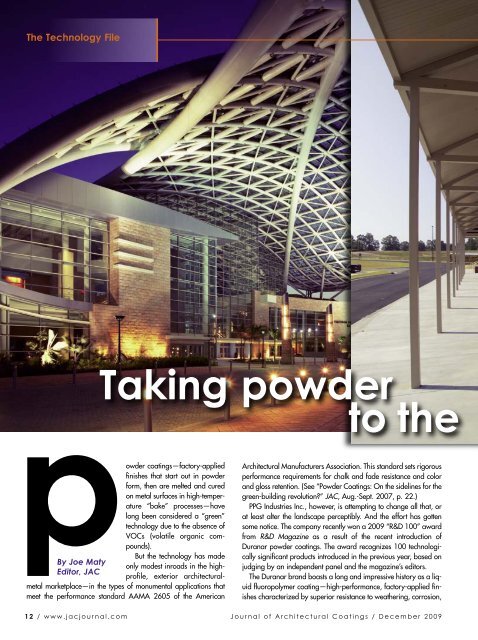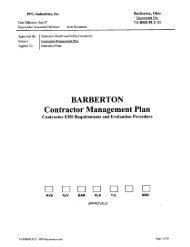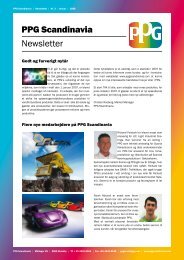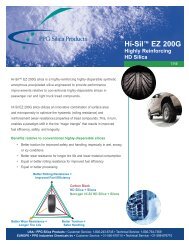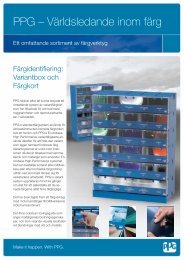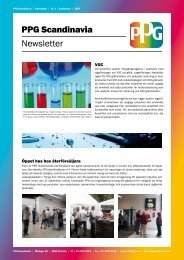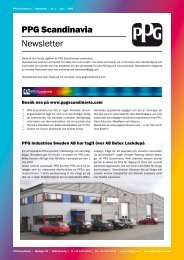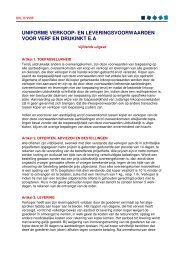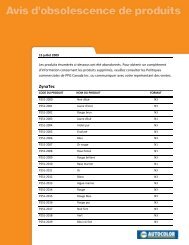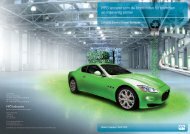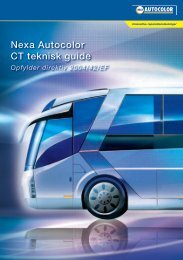Layout 1 - PPG Industries
Layout 1 - PPG Industries
Layout 1 - PPG Industries
You also want an ePaper? Increase the reach of your titles
YUMPU automatically turns print PDFs into web optimized ePapers that Google loves.
The Technology File<br />
pBy Joe Maty<br />
Editor, JAC<br />
Taking powder<br />
to the<br />
owder coatings—factory-applied<br />
finishes that start out in powder<br />
form, then are melted and cured<br />
on metal surfaces in high-temperature<br />
“bake” processes—have<br />
long been considered a “green”<br />
technology due to the absence of<br />
VOCs (volatile organic compounds).<br />
But the technology has made<br />
only modest inroads in the highprofile,<br />
exterior architectural-<br />
metal marketplace—in the types of monumental applications that<br />
meet the performance standard AAMA 2605 of the American<br />
Architectural Manufacturers Association. This standard sets rigorous<br />
performance requirements for chalk and fade resistance and color<br />
and gloss retention. (See “Powder Coatings: On the sidelines for the<br />
green-building revolution?” JAC, Aug.-Sept. 2007, p. 22.)<br />
<strong>PPG</strong> <strong>Industries</strong> Inc., however, is attempting to change all that, or<br />
at least alter the landscape perceptibly. And the effort has gotten<br />
some notice. The company recently won a 2009 “R&D 100” award<br />
from R&D Magazine as a result of the recent introduction of<br />
Duranar powder coatings. The award recognizes 100 technologically<br />
significant products introduced in the previous year, based on<br />
judging by an independent panel and the magazine’s editors.<br />
The Duranar brand boasts a long and impressive history as a liquid<br />
fluoropolymer coating—high-performance, factory-applied finishes<br />
characterized by superior resistance to weathering, corrosion,<br />
1 2 / w w w . j a c j o u r n a l . c o m J o u r n a l o f A r c h i t e c t u r a l C o a t i n g s / D e c e m b e r 2 0 0 9
Advances<br />
in production<br />
process, color proficiency<br />
seen as elevating the technology’s<br />
profile in architectural market<br />
Advances in powder fluoropolymer<br />
coatings are expanding the portfolio<br />
of this high-performance technology.<br />
(Facing page): A liquid-applied silver<br />
metallic fluoropolymer coating was<br />
applied to the undulating "technotropic"<br />
canopy at the Puerto Rico<br />
Convention Center. Photo by Bill<br />
Lemke. (Left): A fluoropolymer powder<br />
coating was used on the walkway<br />
canopy and its supporting beams at<br />
this elementary school in Jonesville,<br />
SC. Photo by Fred Martin.<br />
Photos courtesy of <strong>PPG</strong> <strong>Industries</strong> Inc.<br />
next level<br />
abrasion, extreme temperatures, and chemicals. These properties<br />
are the result of the high bond strength of the fluorine-carbon chemical<br />
bond.<br />
The Duranar coatings are based on PVDF (polyvinylidene fluoride)<br />
resins, widely known by the brand name Kynar, a product of<br />
the chemical company Arkema. Also well-known is the Hylar brand<br />
of PVDF coating resins, manufactured by Solvay Solexis. Other fluoropolymer<br />
coatings—including those capable of ambient cure in<br />
field-applied settings—are based on fluoroethylene vinyl ether<br />
(FEVE) resins.<br />
<strong>PPG</strong> says the Duranar powder coatings are produced with a<br />
unique color-blending and manufacturing process that allows powder<br />
coatings to be economically manufactured in small batches of<br />
custom colors. The process also has the potential to make powder<br />
coatings for architectural aluminum even “greener” by reducing the<br />
material waste and amount of energy used in production, the company<br />
says.<br />
<strong>PPG</strong> and the Duranar powder coatings team—Ron Ambrose,<br />
Kristin Bartlett, the late Dennis Carson, Tony Chasser, Carol Jackson,<br />
Henry Lowman, Steven Sternberger and Howard Wright—were<br />
recognized for the R&D 100 achievement at a recent awards ceremony.<br />
Lowman, <strong>PPG</strong> global director of extrusion coatings, said the<br />
award recognizes the product’s potential “to revolutionize architectural<br />
coatings in a way that benefits both the building industry and<br />
the environment.”<br />
Exhibit A: Color competitiveness<br />
In a recent conversation with JAC, Lowman and Sternberger—<strong>PPG</strong><br />
marketing manager, powder coatings—said the small-batch and<br />
custom-color capabilities of the Duranar powder coatings are<br />
designed to meet the requirements of architects and specifiers who<br />
insist on the color flexibility and range offered by conventional liquid<br />
coatings, but would give powder consideration due to its<br />
“green” profile—zero solvent content, meaning no VOC emissions<br />
during manufacturing or application.<br />
Liquid coatings applied by the coil-coating or spray-coating<br />
process, on the other hand, do contain VOCs, although emissions<br />
are generally contained and eliminated with the use of<br />
high-tech environmental-control systems—at least in major application<br />
facilities.<br />
Liquid fluoropolymer coatings, however, offer some powerful<br />
advantages to the building designer and specifier. These include a<br />
proven track record of long-term performance in high-profile and<br />
monumental building exteriors—20, 30, or more years with<br />
unmatched color and gloss retention—and wide latitude in the<br />
selection of color and finish. Manufacturers of liquid fluoropolymer<br />
coatings—including <strong>PPG</strong>—can mix and match colors, quickly and<br />
in small sample quantities.<br />
With powder coatings, the color-matching process has proven to<br />
be more problematic, essentially involving the entire production<br />
process—blending of formulation components, including color pigments;<br />
extrusion; chilling; processing into a flake material; and<br />
grinding into a powder. Then the powder must be electrostatically<br />
applied to a metal surface, where the color can be evaluated.<br />
<strong>PPG</strong> says the new small-batch process addresses this issue.<br />
“We can make small-batch, custom-color batches economically<br />
now,” Lowman says. He adds that the powder chemistry also carries<br />
certain performance attributes, in particular enhanced curedfilm<br />
hardness. Powder coatings have earned a reputation for hardness<br />
and durability in varied applications, including automotive,<br />
appliance, and other product finishes.<br />
At the same time, Lowman concedes that the powder-coatings<br />
version of Duranar cannot identically match all the color and effect<br />
capabilities of the liquid counterpart. For example, the powder<br />
product cannot produce the same metallic effects. But he observes<br />
that the current construction-market climate—where high-profile,<br />
J o u r n a l o f A r c h i t e c t u r a l C o a t i n g s / D e c e m b e r 2 0 0 9 w w w . j a c j o u r n a l . c o m / 1 3
“monumental” projects are relatively<br />
scarce—lends itself to expanded use of<br />
powder in commercial applications where<br />
special finish effects are less in demand.<br />
Lowman also says the corrosion resistance<br />
of the Duranar coating carries significance<br />
in the many coastal and urban environments<br />
where so many building projects are located.<br />
These environments put building exteriors<br />
to a stern test, due to the presence of<br />
harsh salt and chemical exposures.<br />
“For the design architect, small-batch,<br />
custom-color capability is the key. To the<br />
building owner, corrosion resistance is the<br />
key,” Lowman says. The technology’s superior<br />
durability properties—corrosion resistance<br />
combined with weathering capabilities—are<br />
based on coating systems composed<br />
of a proprietary, high-performance<br />
liquid-applied primer and the highly<br />
durable PVDF topcoat, <strong>PPG</strong> says. The powder<br />
version is reported to offer the “proven<br />
pigmentation and resin technologies as<br />
PVDF polymer-based liquid coatings,” the<br />
company says.<br />
“These are 20-year-plus systems” says<br />
Sternberger.<br />
Lowman and Sternberger also say the<br />
new technology is seen as a bold step forward<br />
in making powder a bigger player in<br />
the global market for high-performance<br />
Liquid-applied fluoropolymer coatings have compiled a long and impressive track record of performance in demanding architectural<br />
applications, the result of the technology’s superior durability in exterior exposures. (Top): Metal panels at the Century Tel Center sports<br />
arena in Bossier City, LA, are finished with a beige-colored fluoropolymer coating. (Above): The rich color of the roof at the Prescott<br />
Gateway Mall, Prescott, AZ, was produced with a fluoropolymer coating. Photos by Wes Thompson.<br />
exterior architectural finishes. Liquid fluoropolymer<br />
coatings enjoy a strong position<br />
in the domestic market, but are less dominant<br />
overseas, particularly in Europe. In<br />
addition, the pollution-control systems that<br />
prevent VOC emissions from factoryapplied<br />
liquid coatings are not universally<br />
present in other geographic regions,<br />
Lowman points out. In these areas, powder<br />
can provide a greener option.<br />
Also entering the debate is the “carbon<br />
footprint” question—which coating system<br />
results in a reduced environmental impact in<br />
terms of the complete product lifecycle. The<br />
jury remains out on this verdict, however.<br />
“Powder reduces VOCs at the point of<br />
application, but you do consume energy in<br />
manufacturing,” Sternberger says. “There<br />
has not been an objective LCA of liquid versus<br />
powder in this regard.”<br />
But he adds, “What’s greener is what lasts<br />
the longest on the building.”<br />
1 4 / w w w . j a c j o u r n a l . c o m J o u r n a l o f A r c h i t e c t u r a l C o a t i n g s / D e c e m b e r 2 0 0 9
Other factors also come into play in making<br />
the choice between powder and liquid<br />
coatings, Sternberger says. The harder<br />
cured film of powder carries weight in certain<br />
high-impact settings, for example. In<br />
addition, some coating facilities may benefit<br />
from the use of powder as an opportunity for<br />
expansion.<br />
“Whenever you have choices, chances<br />
are better for success. The key for <strong>PPG</strong> is that<br />
we can say this offers the same performance<br />
as liquid.”<br />
Weighing the evidence<br />
As a manufacturer of both liquid and powder<br />
factory-applied coatings for architectural<br />
metal building elements such as panels,<br />
roofs, and extrusions, <strong>PPG</strong> recently issued a<br />
“white paper” that offers comparisons and<br />
recommendations on the use of the two types<br />
of coating technologies.<br />
The company says the paper,<br />
Architectural Applications for Liquid and<br />
Powder Fluoropolymer Coatings: A<br />
Comparative Review, provides architects<br />
and curtain-wall consultants with updated<br />
specifying guidelines, and details the aesthetic<br />
and environmental attributes of liquid,<br />
conventional powder, and “next-generation”<br />
powder coatings such as the new Duranar<br />
powder products.<br />
A copy of the white paper can be downloaded<br />
from the <strong>PPG</strong> website located at<br />
www.ppgideascapes.com.<br />
Comparisons and recommendations<br />
addressed in the paper involve considerations<br />
such as VOC content, color and<br />
appearance options, prevailing performance<br />
standards for metal coatings, film<br />
hardness, and cost, among other issues.<br />
The document, for example, makes the<br />
point that the hardness of powder coatings<br />
lends these products to application to surfaces<br />
that are subject to contact from the<br />
public or other sources of wear and abrasion—window<br />
and door frames, storefronts,<br />
railings, and fencing.<br />
Liquid-applied coatings, on the other<br />
hand, can produce bright metallic effects<br />
with the use of metal-flake pigments, while<br />
powder coatings are limited to the use of<br />
mineral-based effect pigments such as mica.<br />
The white paper gives equally high marks<br />
to liquid fluoropolymer coatings and the<br />
“next-generation” powder coatings in a<br />
number of comparison categories, including<br />
appearance properties; corrosion resistance;<br />
applications involving monumentaland<br />
commercial-building curtain walls;<br />
applications in industrial and seacoast environments;<br />
and several other measures.<br />
The next-generation powder coatings are<br />
given superior rankings in a number of categories,<br />
including emissions and waste generation,<br />
energy use, and material transfer.<br />
JAC<br />
For more info, return Reader Inquiry Card


